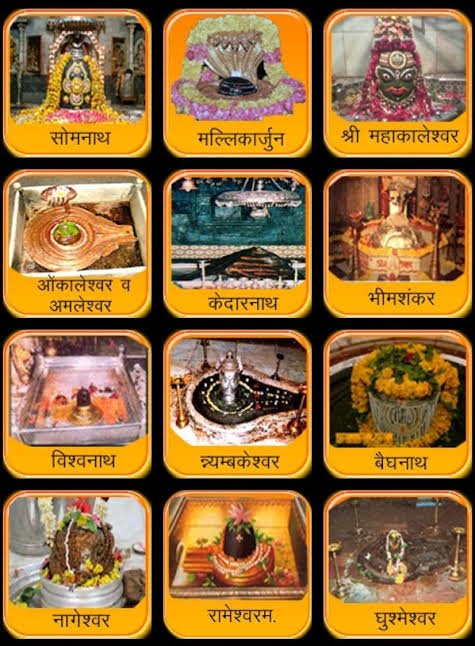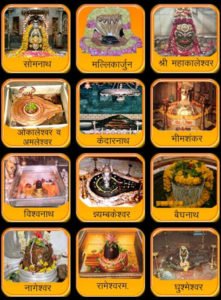TWELVE JYOTIRLINGAS – THE MOST POWERFUL AND AUSPICIOUS FORM OF BHAGWAN SHIVJI


 According to Shivpuran, Bhagwan Shivji assumed the shape of an infinite enlightened pillar (jyotirlinga), piercing the three worlds, to settle the supremacy dispute between Brahma, the creator and Vishnu the preserver. The condition was to find either the beginning or the end of the pillar – whosoever was the first to find the same, would be considered supreme. Brahma assumed the form of a swan and flew to the top to find the origin of the pillar while Vishnu assumed the form of a boar to find it’s terminal point. Neither were successful. However, Brahma lied that he had found the inception point of the pillar but Vishnu honestly admitted that he was unsuccessful in finding the end point of the same. Angered at Brahma’s falsehood, Shivji stated that Brahma will never be worshipped while Vishnu will continue to be revered by innumerable devotees. Hence, to this day, we donot see any temple dedicated to Brahma (except the solitary one at Pushkar, Rajasthan) while Vishnu continues to be worshipped the world over, even in his various avatars.
According to Shivpuran, Bhagwan Shivji assumed the shape of an infinite enlightened pillar (jyotirlinga), piercing the three worlds, to settle the supremacy dispute between Brahma, the creator and Vishnu the preserver. The condition was to find either the beginning or the end of the pillar – whosoever was the first to find the same, would be considered supreme. Brahma assumed the form of a swan and flew to the top to find the origin of the pillar while Vishnu assumed the form of a boar to find it’s terminal point. Neither were successful. However, Brahma lied that he had found the inception point of the pillar but Vishnu honestly admitted that he was unsuccessful in finding the end point of the same. Angered at Brahma’s falsehood, Shivji stated that Brahma will never be worshipped while Vishnu will continue to be revered by innumerable devotees. Hence, to this day, we donot see any temple dedicated to Brahma (except the solitary one at Pushkar, Rajasthan) while Vishnu continues to be worshipped the world over, even in his various avatars.
The Jyotirlinga finally cooled and settled into the sacred mountain of Annamalai, where the Temple of Arunachaleswar is located.However, the enlightened pillar or Jyotirlinga form of Bhagwan Shivji, a symbol of his eternal and infinite presence is now being worshipped as the most prominent and powerful form of Shivji. There are 64 Jyotirlingas out of which 12 are Maha Jyotirlingas or the most auspicious and sacred amongst all the Jyotirlingas.
Each of the 12 Jyotirlinga sites or temples have adopted the name of the presiding deity, a manifestation of Bhagwan Shivji.The twelve temples housing the anadi (beginning less) and anant (endless) form of the Supreme Being, Shivji – the form of a Jyotirlinga, are as follows:
1.Somnath – Considered to be the first amongst the 12 Jyotirlingas, the instant temple worships Shivji as Somnath or the Deity who presides over the moon. It is located in Veraval, Gujarat. The origin of this temple is unknown – may have been constructed anytime between the 1st Century to the 9th Century CE. It has been destroyed by the invading Islamist marauders 16 times and has been rebuilt time and again by the devotees with full dedication to Shivji. Recently Social Media was abuzz with photos of how the Somnath shrine has remained in it’s authentic form, while the land of it’s plunderer, Mahmud of Ghazni, has been devastated. Mahmud, the plunderer haf raided Somnath in 1025 CE, broke the Jyotirlingas situated therein and looted the temple. However, it is Ishwar’s blessings and the strength of our devotion that the shrine remains indestructible.
2.Mallikarjuna – The second Jyotirlinga is located at Srisailam, Andhra Pradesh. The temple is both a Shaktipeeth (the most sacred location where one of Sati’s body parts fell while Shivji was performing tandav with her lifeless body on his shoulders) and a Jyotirlingam. Since thr temple is home to both Shiva and Parvati, Parvati is worshipped as Mallika and Shivji as Arjuna – hence the name Mallikarjuna. As per another tale, when Shivji and Parvati went to Srisailam to stay close to Kartikeya, who had left his paternal abode in anger since his marriage was not arranged by his parents, while his brother Ganesh was married off, the duo were worshipped with Jasmine or Mallika flower. The name Mallikarjuna was derived from the same. Adi Sankaracharya composed his Shivananda Lahari here.
3.Mahakaleshwar – The third Jyotirlinga is located in Ujjain (Avanti), Madhya Pradesh. This is also the site of both the Jyotirlinga and the Shaktipeeth. The significance of the instant temple lies in the fact that here, the Lingam is Swayambhu or arose by itself – a natural creation and not manmade. The idol of Mahakaleshwar is dakshinmukhi or south facing – a unique feature found only in Mahakaleshwar. It also has a Shree Rudra Yantra perched upside down at the ceiling of the Garva Griha, where the Jyotirlinga is placed. Bhagwan Mahakal is the presiding deity of the city of Ujjain and is believed to keep the inhabitants of the city safe from all calamities.
4.Omkareshwar – The fourth Jyotirlinga is located at Khandwa in Madhya Pradesh. There are two temples dedicated to Shivji here – The Omkareshwar or the deity who rules over the pious ‘Om’ sound and the Mamleshwar or the Master of the immortal devas. The former is situated in an island while the latter is situated on the southern bank of the river Narmada, on the mainland.
5.Kedarnath – The 5th Jyotirlinga located in Uttarakhand is revered as the northernmost and closest to Bhagwan Shivji’s eternal abode in Mt. Kailash. Due to extreme cold, being located in the lap of the snow-clad Himalayas, the sacred place remains open to tourists only for six months in a year – from April (Akshyay tritiya) to November (Kartik Purnima). This is a primary locale for spiritual tourism, bring an integral part of the Chardham Yatra, that of Kedarnath, Badrinath, Gangotri and Yamnotri. The devastating flash floods of 2013, which saw much death and destruction in that area, left the Kedarnath temple intact, al large rock amongst the debris having protected it. The earliest reference to Kedarnath is found in the Skanda Puran, which mentions Kedara as the place where Shivji released Maa Ganga from his matted hair. Hence the name Kedarnath or the Master of Kedar. It is also believed that Shivji dived into the earth in the form of a boar from here and emerged at Doleshwar in Kathmandu Valley, Nepal. Hence pure ghee is applied on the lingam at Kedarnath to nurse the injury that the ‘boar’ had received while diving.
6.Bhimashankar – The 6th Jyotirlinga located at Khed Taluka ( Rajgurunagar) near Pune. Located in the Ghat region of the Sahyadri mountains, the shrine derives it’s name from the river Bhima, which flows southeast and merges with the river Krishna near Raichur.
7.Kashi Vishwanath – The 7th Jyotirlinga is the one which will be the cynosure of all attraction currently with the inauguration of the Kashi Vishwanath corridor, to be held shortly. Located at Varanasi (formerly Kashi) on the banks of the sacred river, Ganga, the temple is dedicated to Bhagwan Vishwanath, the deity who rules over the entire Vishwa or the universe. The temple has been vandalized many times by the Islamic plunderers, starting with Mohammed Ghori in the 12th Century, but rebuilt each time by the devoted and noble Shiv bhakts. However, the 6th and the most diabolical Mughal Emperor, Aurangzeb demolished the original temple and built the Gyan Vapi mosque over it. The mosque still bears semblances to the temple’s architecture. In 1780, Ahalyabai Holkar built the current Kashi Vishwanath temole on the plot adjacent to the Gyan Vapi mosque and the temple has since been considered to be one of the most revered religious destination for the hindus.
8.Tryambakeshwar – The 8th Jyotirlinga located at Nasik, Maharashtra on the banks of the river Godavari, is unique in featuring the trinity of Gods – Brahma, Vishnu and Maheshwar on the face of the lingam. Hence the name Tryambakeshwar.
9.Nageshwara – The 9th Jyotirlinga is located in Dwarka, Gujarat. According to Shivpuran, an evil demon Daruka captured and imprisoned a Shiv Bhakt, Supriya in a city under the sea infested with sea serpents and demons. Supriya invoked Shivji to free himself and other prisoners from the clutches of the demon, by chanting the Shiv mantra. Shivji emerged, vanquished Daruka and freed his prisoners. From then on, he started residing in that place as Nageshwara, the god who overpowered the serpents by slaying their master.
10.Baidyanath – The 10th Jyotirlinga is located at Deoghar, Jharkhand. Baidyanath Dham is a temple complex, consisting of 21 temples with the main temple dedicated to Baba Baidyanath, where the Jyotirlingas is installed. According to our ancient scriptures, the demon king of Lanka, Raavan undertook penance at this site to please shivji and with his boon he procured powers to wreck havoc on the innocent mortals. Raavan offered his ten heads one after another as a sacrifice to please Shivji. Seeing his dedication, Shivji himself descended on earth to bless him and heal his injury, thus assuming the role of a Baidya (doctor). Hence the name Baidyanath.
11.Rameshwaram – The 11th Jyotirlinga located in Rameshwaram, Tamil Nadu is revered as the southernmost Jyotirlinga. It is home to the Jyotirlinga known as the pillar of Bhagwan Ram and hence derivrs the name Rameshwaram.
12.Grishneshwar – The 12th or last of the Maha Jyotirlingas, the Temple is dedicated to the benign or most compassionate form of Shivji. Hence the name Grishneshwar or Grishneshwar. It is located at Aurangabad in Maharashtra, less than a kilometer from the Ellora Caves – a UNESCO World Heritage site. This shrine too, like a few other Jyotirlingas bear evidence of Islamic plunder, having been destroyed by the Delhi Sultanate in the 13th and, 14th century. It was rebuilt several times to be dealt a final blow during the Maratha-Mughal conflict, to be rebuilt by Ahalyabai Holkar in the 18th century, after the fall of the Mughal empire.
Each of these sites housing the Jyotirlingas are not only revered by the Hindus but are also important locales for spiritual tourism too, thus providing livelihood to the residents of that area. This is an apt example of Ishwar taking care of the ordinary mortals on earth.
DISCLAIMER: The author is solely responsible for the views expressed in this article. The author carries the responsibility for citing and/or licensing of images utilized within the text.
